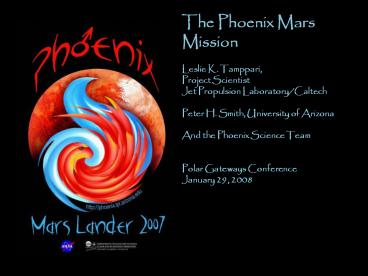The Phoenix Mars Mission - PowerPoint PPT Presentation
Title:
The Phoenix Mars Mission
Description:
Title: Proposal Name Author: sedivy Last modified by: John F. Cooper Created Date: 12/11/2001 11:23:40 PM Document presentation format: On-screen Show – PowerPoint PPT presentation
Number of Views:325
Avg rating:3.0/5.0
Title: The Phoenix Mars Mission
1
The Phoenix Mars Mission Leslie K.
Tamppari, Project Scientist Jet Propulsion
Laboratory/Caltech Peter H. Smith, University of
Arizona And the Phoenix Science Team Polar
Gateways Conference January 29, 2008
- The Phoenix Mars Mission
- Doug Lombardi
- Education and Public Outreach Manager
- Lunar and Planetary Laboratory
- The University of Arizona
- lombardi_at_lpl.arizona.edu
- http//phoenix.lpl.arizona.edu
2
(No Transcript)
3
Odyssey Gamma Ray Subsystem sees ice within the
top meter of the surface (July 2002)
Models predict ice Dark blue signal shows high H
content
Goal 1 Study the history of and current state
of water Was there past standing water?
Does unfrozen water exist? What processes
shape the surface? What is the amount and
state of water in the atmosphere? How much
water is in the surface vs. the atmosphere? Goal
2 Search for habitable zones (not life
detection) Are there organics in the soil and
do they vary with depth? Are there other
biogenic elements? Can unfrozen water layers
exist? Is the soil acidic or basic?
4
Phoenix Reborn from 2 previous spacecraft
2001 Mars Lander Spacecraft
1998 Mars Polar Lander
Phoenix
5
MECA wet chemistry
TEGA
6
MECA Wet Chemistry and theThermal and
Evolved-gas Analyzer (TEGA)
7
Robotic Armice tool, scraper blades, scoop
2.35m (77)
Yao Ming (76)
Thermal and electrical conductivity probe
8
Ice acquisition tools
TECP
Primary Blade
Secondary Blade
Rasp
9
Robotic Arm camera
Surface Stereo Imager
Optical and Atomic-force Microscopy
10
Imaging at multiple scales
Robotic arm camera can see scoop particles as
small as 0.5 mm
- Panoramic color/stereo imager can see trench
layers or particles as small as 2 mm
11
Microscopy station (0.1-2000 mm resolution)
30 cm
Microscopes and sample wheel
This optical microscope image particles is a
composite of 3 pictures taken under red, green,
and blue illumination
AFM on sand exposed to aeolian and aqueous
erosion
AFM on ice crystal on mica
aeolian erosion
aqueous erosion
12
Met Mast T, P, telltale
LIDAR
13
Where is the best place to land?
Science Access to ice Evidence
for ice processes Latitude 65º -72º N
Safety Elevation lt-3500 m
Slopes lt 16º Small amount of large
rocks 35 cm high rock is damaging
No large hazards (craters) Ellipse
150x30 km (100x20 mi)
D
B
14
(No Transcript)
15
(No Transcript)
16
D
17
(No Transcript)
18
The Valley of Safety
19
What might the surface look like?The Antarctic
Dry Valleys?
M. Mellon
20
Phoenix will make significant steps forward in
our understanding of the history of water and the
habitability potential of the north polar region
of Mars
http//phoenix.lpl.arizona.edu































